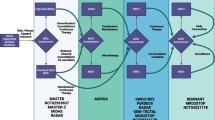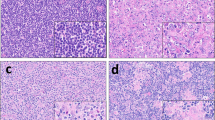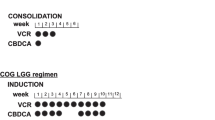Abstract
Bruton’s tyrosine kinase inhibitors (BTKi) exhibit superior efficacy in relapsed/refractory primary central nervous system lymphoma (PCNSL), but few studies have evaluated patients with newly diagnosed PCNSL, and even fewer studies have evaluated differences in efficacy between treatment with BTKi and traditional chemotherapy. This study retrospectively analyzed the clinical characteristics of 86 patients with PCNSL and identified predictors of poor prognosis for overall survival (OS). After excluding patients who only received palliative care, 82 patients were evaluated for efficacy and survival. According to the induction regimen, patients were divided into the traditional chemotherapy, BTKi combination therapy, and radiotherapy groups; the objective response rates (ORR) of the three groups were 71.4%, 96.2%, and 71.4% (P = 0.037), respectively. Both median progression-free survival and median duration of remission showed statistically significant differences (P = 0.019 and P = 0.030, respectively). The median OS of the BTKi-containing therapy group was also longer than that of the traditional chemotherapy group (not reached versus 47.8 (32.5–63.1) months, P = 0.038).Seventy-one patients who achieved an ORR were further analyzed, and achieved an ORR after four cycles of treatment and maintenance therapy had prolonged OS (P = 0.003 and P = 0.043, respectively). In conclusion, survival, and prognosis of patients with newly diagnosed PCNSL are influenced by the treatment regimen, with the BTKi-containing regimen showing great potential.




Similar content being viewed by others
Data availability
No datasets were generated or analysed during the current study.
References
Villano JL, Koshy M, Shaikh H et al (2011) Age, gender, and racial differences in incidence and survival in primary CNS lymphoma. Br J Cancer 105(9):1414–1418. https://doi.org/10.1038/bjc.2011.357
Mendez JS, Ostrom QT, Gittleman H et al (2018) The elderly left behind-changes in survival trends of primary central nervous system lymphoma over the past 4 decades. Neurooncology 20(5):687–694. https://doi.org/10.1093/neuonc/nox187
Barajas RF, Politi LS, Anzalone N et al (2021) Consensus recommendations for MRI and PET imaging of primary central nervous system lymphoma: guideline statement from the International Primary CNS Lymphoma Collaborative Group (IPCG). Neurooncology 23(7):1056–1071. https://doi.org/10.1093/neuonc/noab020
Chen T, Liu Y, Wang Y et al (2022) Evidence-based expert consensus on the management of primary central nervous system lymphoma in China. J Hematol Oncol 15(1):136. https://doi.org/10.1186/s13045-022-01356-7
Loghavi S, Kanagal-Shamanna R, Khoury JD et al (2023) Modern pathology: an official journal of the United States and Canadian Academy of Pathology, Inc, 100397. https://doi.org/10.1016/j.modpat.2023.100397. 5th edition of the world health classification of tumors of the hematopoietic and lymphoid tissues. Advance online publication
Lebrun L, Allard-Demoustiez S, Salmon I (2023) Pathology and new insights in central nervous system lymphomas. Curr Opin Oncol 35(5):347–356. https://doi.org/10.1097/CCO.0000000000000978
Woo HY, Chae SW, DO SI et al (2022) Clinicopathological characterization of primary diffuse large B-Cell lymphoma of the Central Nervous System. Anticancer Res 42(11):5601–5608. https://doi.org/10.21873/anticanres.16068
Ferreri AJM, Calimeri T, Cwynarski K et al (2023) Primary central nervous system lymphoma. Nat Reviews Disease Primers 9(1):29. https://doi.org/10.1038/s41572-023-00439-0
Schaff LR, Grommes C (2022) Primary central nervous system lymphoma. Blood 140(9):971–979. https://doi.org/10.1182/blood.2020008377
Yuan Y, Ding T, Wang S et al (2021) Current and emerging therapies for primary central nervous system lymphoma. Biomark Res 9(1):32. https://doi.org/10.1186/s40364-021-00282-z
Shibamoto Y, Ogino H, Hasegawa M et al (2005) Results of radiation monotherapy for primary central nervous system lymphoma in the 1990s. Int J Radiat Oncol Biol Phys 62(3):809–813. https://doi.org/10.1016/j.ijrobp.2004.12.043
Houillier C, Soussain C, Ghesquières H et al (2020) Management and outcome of primary CNS lymphoma in the modern era: an LOC network study. Neurology 94(10):e1027–e1039. https://doi.org/10.1212/WNL.0000000000008900
Lewis KL, Cheah CY (2021) Non-covalent BTK inhibitors-the New BTKids on the Block for B-Cell malignancies. J Personalized Med 11(8):764. https://doi.org/10.3390/jpm11080764
Leitinger DE, Kaplan DZ (2022) BTK inhibitors in Haematology: Beyond B Cell malignancies. Transfus Med Rev 36(4):239–245. https://doi.org/10.1016/j.tmrv.2022.06.009
Bonzheim I, Sander P, Salmerón-Villalobos J et al (2022) The molecular hallmarks of primary and secondary vitreoretinal lymphoma. Blood Adv 6(5):1598–1607. https://doi.org/10.1182/bloodadvances.2021004212
Pal Singh S, Dammeijer F, Hendriks RW (2018) Role of Bruton’s tyrosine kinase in B cells and malignancies. Mol Cancer 17(1):57. https://doi.org/10.1186/s12943-018-0779-z
Cetin GO, Baris IC, Caner V et al (2016) Mutational status of EZH2 and CD79B hot spots in mature B-cell non-hodgkin’s lymphomas: novel CD79B variations have been revealed. Eur Rev Med Pharmacol Sci 20(5):830–836
Wu K, Zhang H, Fu Y et al (2018) TLR4/MyD88 signaling determines the metastatic potential of breast cancer cells. Mol Med Rep 18(3):3411–3420. https://doi.org/10.3892/mmr.2018.9326
Ollila TA, Olszewski AJ (2018) Extranodal diffuse large B cell lymphoma: molecular features, prognosis, and risk of Central Nervous System recurrence. Curr Treat Options Oncol 19(8):38. https://doi.org/10.1007/s11864-018-0555-8
Nagane M (2022) Molecular pathogenesis and therapeutic development of primary central nervous system lymphoma: update and future perspectives. Japanese J Clin Hematol 63(9):1145–1156. https://doi.org/10.11406/rinketsu.63.1145
Grommes C, Tang SS, Wolfe J et al (2019) Phase 1b trial of an ibrutinib-based combination therapy in recurrent/refractory CNS lymphoma. Blood 133(5):436–445. https://doi.org/10.1182/blood-2018-09-875732
Soussain C, Choquet S, Blonski M et al (2019) Ibrutinib monotherapy for relapse or refractory primary CNS lymphoma and primary vitreoretinal lymphoma: Final analysis of the phase II ‘proof-of-concept’ iLOC study by the Lymphoma study association (LYSA) and the French oculo-cerebral lymphoma (LOC) network. European journal of cancer (Oxford, England: 1990), 117, 121–130. https://doi.org/10.1016/j.ejca.2019.05.024
Abrey LE, Batchelor TT, Ferreri AJ, International Primary CNS Lymphoma Collaborative Group (2005) Report of an international workshop to standardize baseline evaluation and response criteria for primary CNS lymphoma. J Clin Oncology: Official J Am Soc Clin Oncol 23(22):5034–5043. https://doi.org/10.1200/JCO.2005.13.524
Batchelor TT (2016) Primary central nervous system lymphoma. Hematology. American Society of Hematology. Education Program, 2016(1), 379–385. https://doi.org/10.1182/asheducation-2016.1.379
Tang D, Chen Y, Shi Y et al (2022) Epidemiologic Characteristics, prognostic factors, and treatment outcomes in primary Central Nervous System Lymphoma: a SEER-Based study. Front Oncol 12:817043. https://doi.org/10.3389/fonc.2022.817043
Chen C, Sun P, Sun XQ et al (2023) Primary treatment and recent survival trends in patients with primary diffuse large B-cell lymphoma of central nervous system, 1995–2016: a population-based SEER analysis. Hematol Oncol 41(2):248–256. https://doi.org/10.1002/hon.2918
van der Meulen M, Dinmohamed AG, Visser O et al (2017) Improved survival in primary central nervous system lymphoma up to age 70 only: a population-based study on incidence, primary treatment and survival in the Netherlands, 1989–2015. Leukemia 31(8):1822–1825. https://doi.org/10.1038/leu.2017.128
Farrall AL, Smith JR (2021) Changing incidence and survival of primary Central Nervous System Lymphoma in Australia: a 33-Year National Population-based study. Cancers 13(3):403. https://doi.org/10.3390/cancers13030403
Fukumura K, Kawazu M, Kojima S et al (2016) Genomic characterization of primary central nervous system lymphoma. Acta Neuropathol 131(6):865–875. https://doi.org/10.1007/s00401-016-1536-2
Nayyar N, White MD, Gill CM et al (2019) MYD88 L265P mutation and CDKN2A loss are early mutational events in primary central nervous system diffuse large B-cell lymphomas. Blood Adv 3(3):375–383. https://doi.org/10.1182/bloodadvances.2018027672
Lee JH, Jeong H, Choi JW et al (2017) Clinicopathologic significance of MYD88 L265P mutation in diffuse large B-cell lymphoma: a meta-analysis. Sci Rep 7(1):1785. https://doi.org/10.1038/s41598-017-01998-5
Ferreri AJ, Blay JY, Reni M et al (2003) Prognostic scoring system for primary CNS lymphomas: the International Extranodal Lymphoma Study Group experience. J Clin Oncology: Official J Am Soc Clin Oncol 21(2):266–272. https://doi.org/10.1200/JCO.2003.09.139
Abrey LE, Ben-Porat L, Panageas KS et al (2006) Primary central nervous system lymphoma: the Memorial Sloan-Kettering Cancer Center prognostic model. J Clin Oncology: Official J Am Soc Clin Oncol 24(36):5711–5715. https://doi.org/10.1200/JCO.2006.08.2941
Liu CJ, Lin SY, Yang CF et al (2020) A new prognostic score for disease progression and mortality in patients with newly diagnosed primary CNS lymphoma. Cancer Med 9(6):2134–2145. https://doi.org/10.1002/cam4.2872
Shen J, Liu J (2022) Bruton’s tyrosine kinase inhibitors in the treatment of primary central nervous system lymphoma: a mini-review. Front Oncol 12:1034668. https://doi.org/10.3389/fonc.2022.1034668
Grommes C, Pastore A, Palaskas N et al (2017) Ibrutinib unmasks critical role of Bruton Tyrosine Kinase in Primary CNS Lymphoma. Cancer Discov 7(9):1018–1029. https://doi.org/10.1158/2159-8290.CD-17-0613
Renaud L, Bossard JB, Carpentier B et al (2021) Treatment with temozolomide and ibrutinib in recurrent/refractory primary (PCNSL) and secondary CNS lymphoma (SCNSL). Eur J Haematol 107(3):370–373. https://doi.org/10.1111/ejh.13667
Lauer EM, Waterhouse M, Braig M et al (2020) Ibrutinib in patients with relapsed/refractory central nervous system lymphoma: a retrospective single-centre analysis. Br J Haematol 190(2):e110–e114. https://doi.org/10.1111/bjh.16759
Lewis KL, Chin CK, Manos K et al (2021) Ibrutinib for central nervous system lymphoma: the Australasian Lymphoma Alliance/MD Anderson Cancer Center experience. Br J Haematol 192(6):1049–1053. https://doi.org/10.1111/bjh.16946
Estupiñán HY, Berglöf A, Zain R et al (2021) Comparative analysis of BTK inhibitors and mechanisms underlying adverse effects. Front cell Dev Biology 9:630942. https://doi.org/10.3389/fcell.2021.630942
Munir T, Brown JR, O’Brien S et al (2019) Final analysis from RESONATE: up to six years of follow-up on ibrutinib in patients with previously treated chronic lymphocytic leukemia or small lymphocytic lymphoma. Am J Hematol 94(12):1353–1363. https://doi.org/10.1002/ajh.25638
Lionakis MS, Dunleavy K, Roschewski M et al (2017) Inhibition of B cell receptor signaling by Ibrutinib in primary CNS Lymphoma. Cancer Cell 31(6):833–843e5. https://doi.org/10.1016/j.ccell.2017.04.012
Zhang Y, Li Y, Zhuang Z et al (2021) Preliminary evaluation of Zanubrutinib-Containing regimens in DLBCL and the cerebrospinal fluid distribution of Zanubrutinib: a 13-Case Series. Front Oncol 11:760405. https://doi.org/10.3389/fonc.2021.760405
Song Y, Deng L, Zhang B et al (2021) Preliminary results of orelabrutinib concentrations in peripheral blood and cerebrospinal fluid in patients with relapsed/refractory primary or secondary CNS lymphoma. In CSCO, 24th Annual Meeting
Hillmen P, Brown JR, Eichhorst BF et al (2020) ALPINE: zanubrutinib versus ibrutinib in relapsed/refractory chronic lymphocytic leukemia/small lymphocytic lymphoma. Future Oncol (London England) 16(10):517–523. https://doi.org/10.2217/fon-2019-0844
Tam CS, Opat S, D’Sa S et al (2020) A randomized phase 3 trial of zanubrutinib vs ibrutinib in symptomatic Waldenström macroglobulinemia: the ASPEN study. Blood 136(18):2038–2050. https://doi.org/10.1182/blood.2020006844
Dhillon S (2021) Orelabrutinib: first approval. Drugs 81(4):503–507. https://doi.org/10.1007/s40265-021-01482-5
Zhao S, Liu Y, Zhu Z et al (2022) Orelabrutinib, Rituximab, and high-dose methotrexate (HD-MTX) in newly diagnosed primary Central Nervous System Lymphoma (PCNSL): a retrospective analysis on Efficacy, Safety, and Biomarker. Blood 140(Supplement 1):1338–1339
Vu K, Mannis G, Hwang J et al (2019) Low-dose lenalidomide maintenance after induction therapy in older patients with primary central nervous system lymphoma. Br J Haematol 186(1):180–183. https://doi.org/10.1111/bjh.15787
Faivre G, Butler MJ, Le I et al (2019) Temozolomide as a single Agent maintenance therapy in Elderly patients with primary CNS lymphoma. Clin Lymphoma Myeloma Leuk 19(10):665–669. https://doi.org/10.1016/j.clml.2019.05.012
Acknowledgements
We thank all participating institutions and physicians for their support of this study.
Funding
This work did not receive any specific grant from funding agencies in the public, commercial, or not-for-profit sectors.
Author information
Authors and Affiliations
Contributions
Bai SJ and Yang LH were the main authors of the paper, and equally designed and planned the study; Bai SJ wrote the manuscript; Bai SJ, Yang LH and He JX oversaw data pooling, data checking and statistical analysis; Zheng YJ, Geng Y, Gao YN, Zhang CX and Wang YR made contributions to the acquisition of clinical data.Qin LY and Wang WJ performed the collection and collation of the experimental data.All authors read and approved the final version of the manuscript.
Corresponding author
Ethics declarations
Competing interests
The authors declare no competing interests.
Additional information
Publisher’s Note
Springer Nature remains neutral with regard to jurisdictional claims in published maps and institutional affiliations.
Electronic supplementary material
Below is the link to the electronic supplementary material.
Rights and permissions
Springer Nature or its licensor (e.g. a society or other partner) holds exclusive rights to this article under a publishing agreement with the author(s) or other rightsholder(s); author self-archiving of the accepted manuscript version of this article is solely governed by the terms of such publishing agreement and applicable law.
About this article
Cite this article
Bai, SJ., He, JX., Zheng, YJ. et al. Clinical characteristics and prognosis of patients with newly diagnosed primary central nervous system lymphoma: a multicentre retrospective analysis. Ann Hematol (2024). https://doi.org/10.1007/s00277-024-05797-7
Received:
Accepted:
Published:
DOI: https://doi.org/10.1007/s00277-024-05797-7




